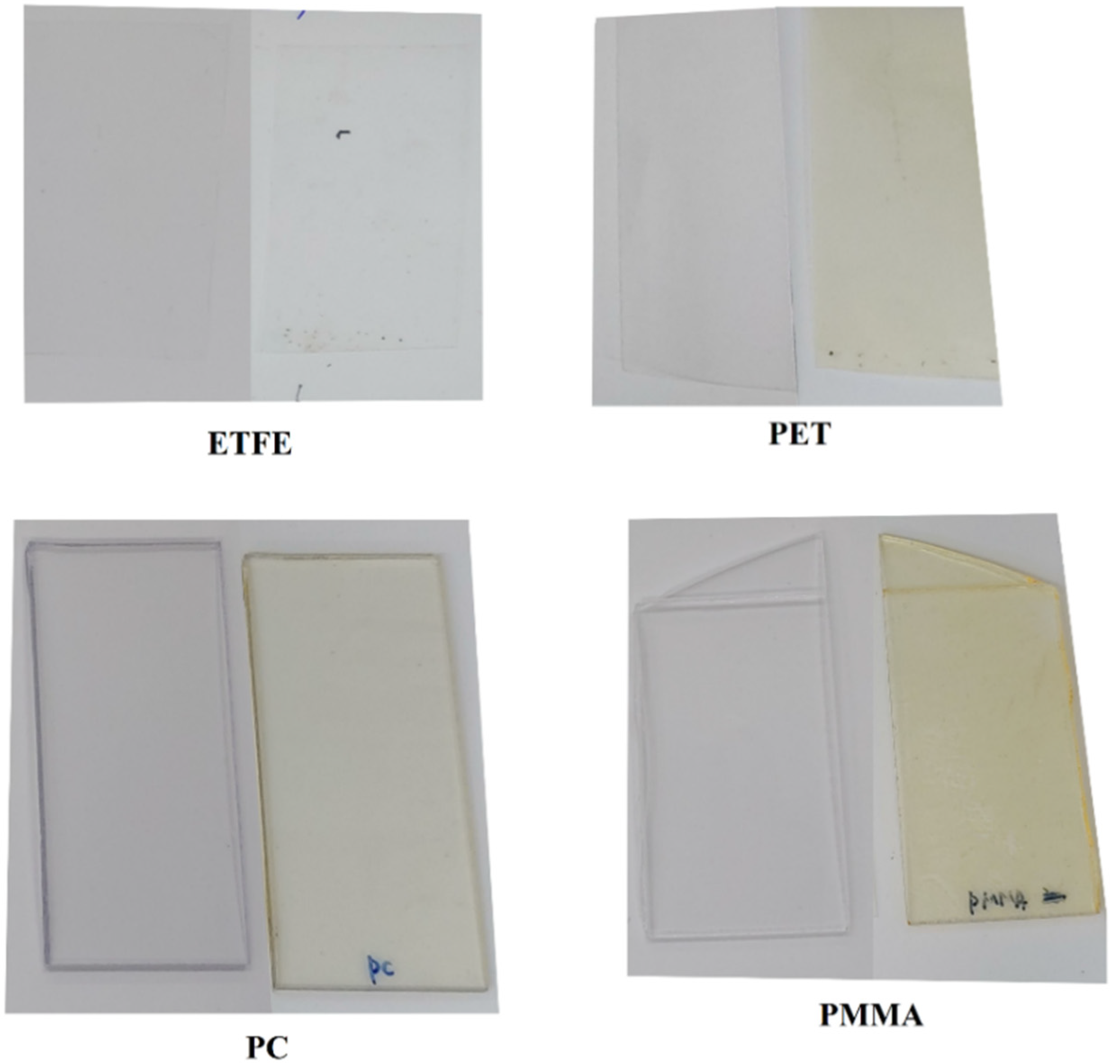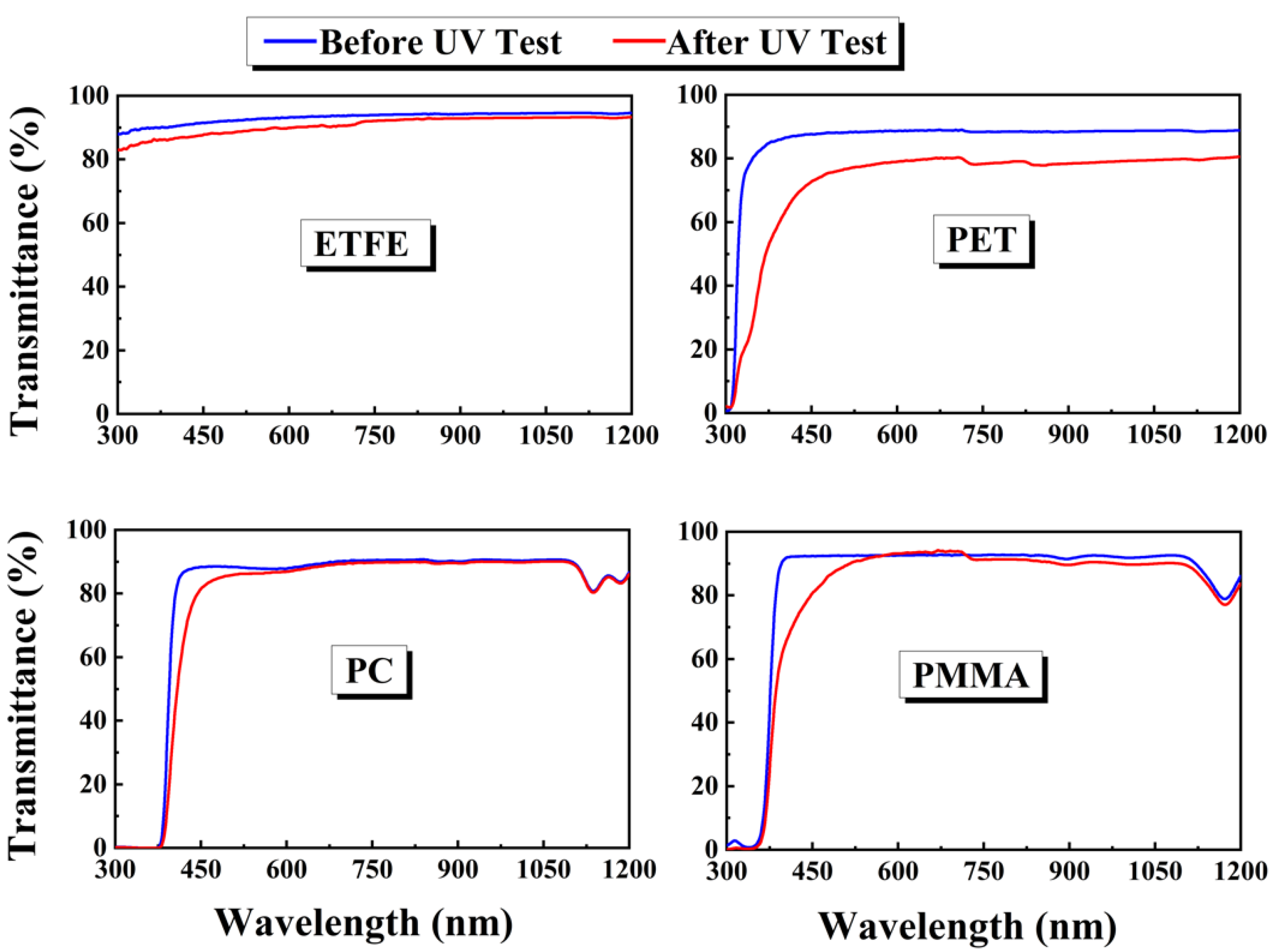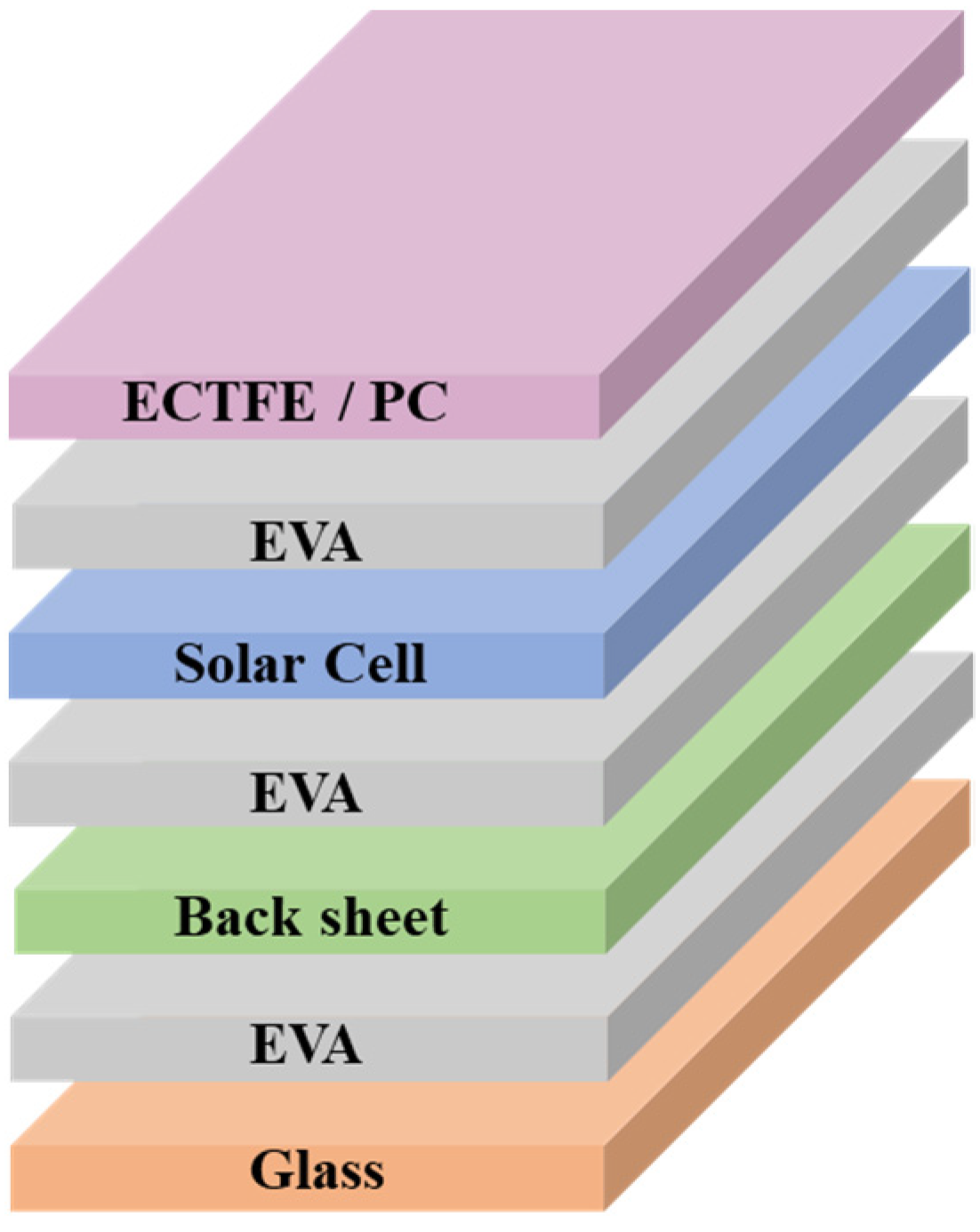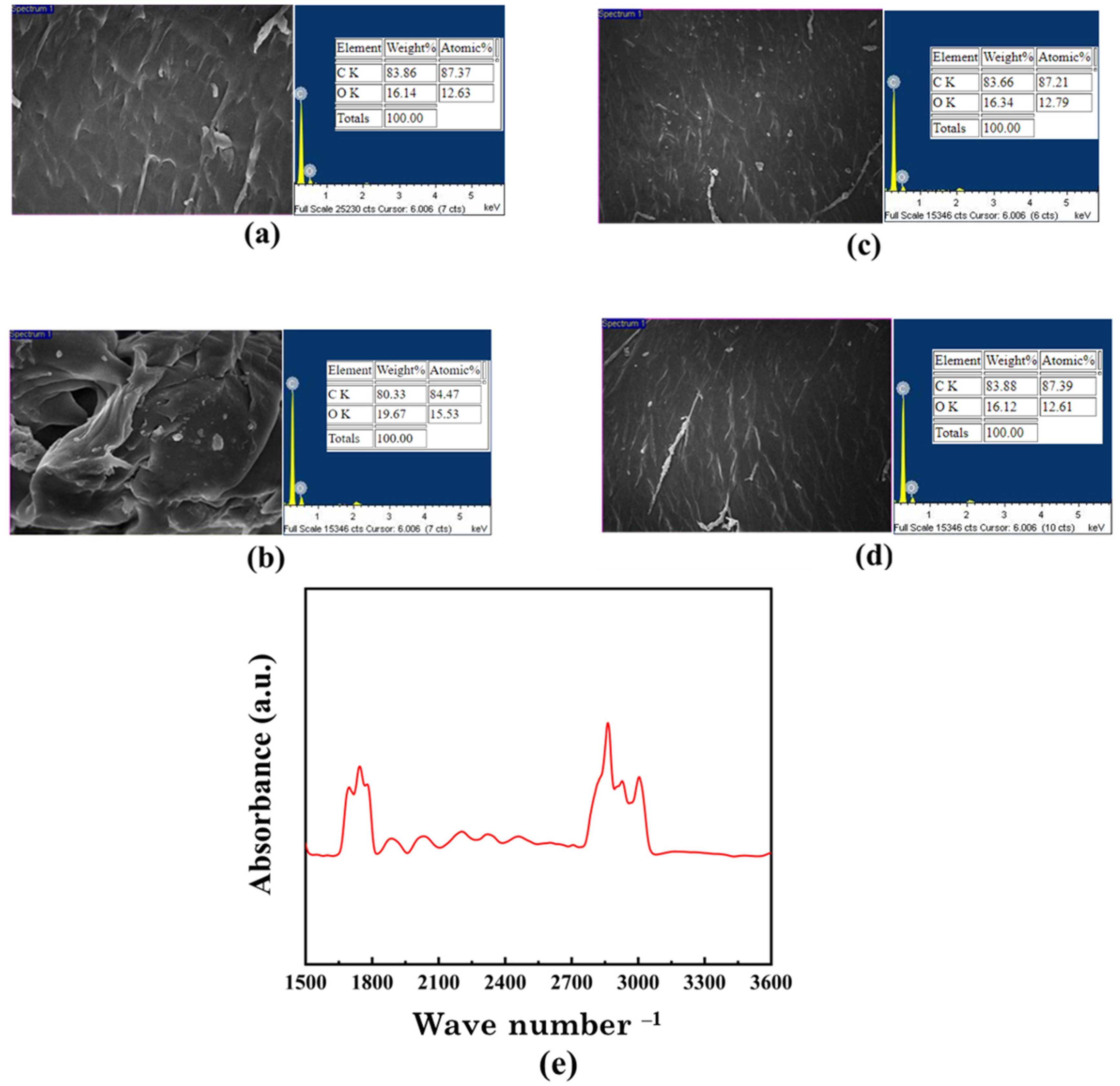The Influence of UV Light Exposure on the Reliability of Various Front Materials for Lightweight PV Module
Abstract
:1. Introduction
2. Materials and Methods
3. Results and Discussions
3.1. UV Test Analysis of Lightweight Front Materials
3.2. Fabrication of PV Module Using Front Materials
3.3. Surface Characterization
3.4. I–V Curve Analysis
4. Conclusions
Author Contributions
Funding
Acknowledgments
Conflicts of Interest
References
- Baharwani, V.; Meena, N.; Dubey, A.; Brighu, U.; Mathur, J. Life cycle analysis of solar PV system: A review. Int. J. Environ. Res. Dev. 2014, 4, 183–190. [Google Scholar]
- Shukla, A.K.; Sudhakar, K.; Baredar, P.; Mamat, R. BIPV based sustainable building in South Asian countries. Sol. Energy 2018, 170, 1162–1170. [Google Scholar] [CrossRef]
- El Hammoumi, A.; Chalh, A.; Allouhi, A.; Motahhir, S.; El Ghzizal, A.; Derouich, A. Design and construction of a test bench to investigate the potential of floating PV systems. J. Clean. Prod. 2021, 278, 123917. [Google Scholar] [CrossRef]
- Elborg, M. Reducing land competition for agriculture and photovoltaic energy generation–A comparison of two agro-photovoltaic plants in Japan. In Proceedings of the International Conference on Sustainable and Renewable Energy Development and Design (SREDD2017), Royal University of Bhutan (RUB), Mohithang Thimphu, Bhutan, 3–5 April 2017; Volume 3, p. 5. [Google Scholar]
- Shaikh, P.H.; Nor, N.B.M.; Sahito, A.A.; Nallagownden, P.; Elamvazuthi, I.; Shaikh, M.S. Building energy for sustainable development in Malaysia: A review. Renew. Sustain. Energy Rev. 2017, 75, 1392–1403. [Google Scholar] [CrossRef]
- Martins, A.C.; Chapuis, V.; Virtuani, A.; Ballif, C. Ultra-lightweight PV module design for building integrated photovoltaics. In Proceedings of the 2017 IEEE 44th Photovoltaic Specialist Conference (PVSC), Washington, DC, USA, 25–30 June 2017; pp. 2104–2108. [Google Scholar]
- Kajisa, T.; Miyauchi, H.; Mizuhara, K.; Hayashi, K.; Tokimitsu, T.; Inoue, M.; Hara, K.; Masuda, A. Novel lighter weight crystalline silicon photovoltaic module using acrylic-film as a cover sheet. Jpn. J. Appl. Phys. 2014, 53, 92302. [Google Scholar] [CrossRef]
- Martins, A.C.; Chapuis, V.; Sculati-Meillaud, F.; Virtuani, A.; Ballif, C. Light and durable: Composite structures for building-integrated photovoltaic modules. Prog. Photovolt. Res. Appl. 2018, 26, 718–729. [Google Scholar] [CrossRef]
- Zahid, M.A.; Hussain, S.Q.; Cho, Y.H.; Yi, J. Optical properties of CaF2 thin film deposited on borosilicate glass and its electrical performance in PV module applications. Appl. Sci. 2020, 10, 5647. [Google Scholar] [CrossRef]
- Halbe, A.; Novak, J.; Sharpe, K.; Housser, G.; Haldars, P. Evaluation of mounting mechanisms for the installation of lightweight PV systems on commercial rooftops. In Proceedings of the 2014 IEEE 40th Photovoltaic Specialist Conference (PVSC), Denver, CO, USA, 8–13 June 2014; pp. 3539–3542. [Google Scholar]
- Honeker, C.; Fuller, E.; Watts, A.; Booth, D.; Flaherty, B.; Mao, E. Reducing installed costs of residential solar by the use of adhesive mounted lightweight solar modules. In Proceedings of the 2016 IEEE 43rd Photovoltaic Specialists Conference (PVSC), Portland, OR, USA, 5–10 June 2016; pp. 3135–3140. [Google Scholar]
- Metacarpa, D.; Fobare, D.; Garney, A.; Yan, F.; Dwyer, D.; Holton, E.; Haldar, P. Reduced balance of system costs using lightweight photovoltaics integrated with roofing material membranes. In Proceedings of the 2015 IEEE 42nd Photovoltaic Specialist Conference (PVSC), New Orleans, LO, USA, 14–19 June 2015; pp. 1–4. [Google Scholar]
- Lamnatou, C.; Moreno, A.; Chemisana, D.; Reitsma, F.; Clariá, F. Ethylene tetrafluoroethylene (ETFE) material: Critical issues and applications with emphasis on buildings. Renew. Sustain. Energy Rev. 2018, 82, 2186–2201. [Google Scholar] [CrossRef]
- Sulyman, M.; Haponiuk, J.; Formela, K. Utilization of recycled polyethylene terephthalate (PET) in engineering materials: A review. Int. J. Environ. Sci. Dev. 2016, 7, 100. [Google Scholar] [CrossRef]
- Liu, Y.; Li, Q.; Shao, H. Properties of ZnO: Al films deposited on polycarbonate substrate. Vacuum 2009, 83, 1435–1437. [Google Scholar] [CrossRef]
- Le Bail, N.; Benayoun, S.; Toury, B. Mechanical properties of sol–gel coatings on polycarbonate: A review. J. Sol Gel Sci. Technol. 2015, 75, 710–719. [Google Scholar] [CrossRef]
- Brounne, M.; Heuseveldt, J.W.; Rosca, V.; Okel, L.A.G. Novel light-weight PV module design based on use of polycarbonate. In Proceedings of the International Conference EU PVSEC for Photovoltaic Research, Brussels, Belgium, 24–28 September 2018; p. 1. [Google Scholar]
- Pawar, E. A review article on acrylic PMMA. IOSR J. Mech. Civ. Eng. 2016, 13, 1–4. [Google Scholar]
- Holley, W.H. Semiannual Technical Progress Report: Advanced Development of PV Encapsulants. Annual Subcontract Report, 1 January 1993–30 June 1993; National Renewable Energy Lab., Springborn Labs: Golden, CO, USA, 1993. [Google Scholar]
- Burrows, K.; Fthenakis, V. Glass needs for a growing photovoltaics industry. Sol. Energy Mater. Sol. Cells 2015, 132, 455–459. [Google Scholar] [CrossRef]
- Dunlop, E.D.; Halton, D.; Ossenbrink, H.A. 20 years of life and more: Where is the end of life of a PV module? In Proceedings of the Conference Record of the Thirty-first IEEE Photovoltaic Specialists Conference, Lake Buena Vista, FL, USA, 3–7 January 2005; pp. 1593–1596. [Google Scholar]
- Pern, J. Module Encapsulation Materials, Processing and Testing (Presentation); National Renewable Energy Lab. (NREL): Golden, CO, USA, 2008. [Google Scholar]
- King, D.L.; Quintana, M.A.; Kratochvil, J.A.; Ellibee, D.E.; Hansen, B.R. Photovoltaic module performance and durability following long-term exposure. In Proceedings of the Photovoltaic Performance and Reliability Workshop, AIP Conference Proceedings, Vail, CO, USA, 18–21 October 1999; Volume 462, pp. 565–571. [Google Scholar]
- Parretta, A.; Bombace, M.; Graditi, G.; Schioppo, R. Optical degradation of long-term, field-aged c-Si photovoltaic modules. Sol. Energy Mater. Sol. Cells 2005, 86, 349–364. [Google Scholar] [CrossRef]
- Redjala, S.; Aït Hocine, N.; Ferhoum, R.; Gratton, M.; Poirot, N.; Azem, S. UV Aging Effects on Polycarbonate Properties. J. Fail. Anal. Prev. 2020, 20, 1907–1916. [Google Scholar] [CrossRef]
- Lim, J.R.; Shin, W.G.; Lee, C.G.; Lee, Y.G.; Ju, Y.C.; Ko, S.W.; Kim, J.D.; Kang, G.H.; Hwang, H. A Study of the Electrical Output and Reliability Characteristics of the Crystalline Photovoltaic Module According to the Front Materials. Energies 2020, 14, 163. [Google Scholar] [CrossRef]
- Jang, W.; Shin, D.; Choi, S.; Park, S.; Han, H. Effects of internal linkage groups of fluorinated diamine on the optical and dielectric properties of polyimide thin films. Polymer 2007, 48, 2130–2143. [Google Scholar] [CrossRef]
- De Castro Monsores, K.G.; da Silva, A.O.; de Oliveira, S.S.; Rodrigues, J.G.P.; Weber, R.P. Influence of ultraviolet radiation on polymethylmethacrylate (PMMA). J. Mater. Res. Technol. 2019, 8, 3713–3718. [Google Scholar] [CrossRef]
- Clark, D.T.; Abu-Shbak, M.M. Surface aspects of the heat treatment of polyethylene terephthalate as revealed by ESCA. Polym. Degrad. Stab. 1984, 9, 225–237. [Google Scholar] [CrossRef]
- Factor, A.; Chu, M.L. The role of oxygen in the photo-ageing of bisphenol-A polycarbonate. Polym. Degrad. Stab. 1980, 2, 203–223. [Google Scholar] [CrossRef]
- Buxbaum, L.H. The degradation of poly (ethylene terephthalate). Angew. Chem. Int. Ed. Engl. 1968, 7, 182–190. [Google Scholar] [CrossRef]
- Day, M.; Wiles, D.M. Photochemical degradation of poly (ethylene terephthalate). III. Determination of decomposition products and reaction mechanism. J. Appl. Polym. Sci. 1972, 16, 203–215. [Google Scholar] [CrossRef]
- Sang, T.; Wallis, C.J.; Hill, G.; Britovsek, G.J.P. Polyethylene terephthalate degradation under natural and accelerated weathering conditions. Eur. Polym. J. 2020, 136, 109873. [Google Scholar] [CrossRef]
- Badiee, A.; Wildman, R.; Ashcroft, I. Effect of UV aging on degradation of Ethylene-vinyl Acetate (EVA) as encapsulant in photovoltaic (PV) modules. In Proceedings of the Reliability of Photovoltaic Cells, Modules, Components, and Systems VII, San Diego, CA, USA, 17–21 August 2014; Volume 9179, p. 91790O. [Google Scholar]
- Meyer, E.L. On the Reliablity, Degradation and Failure of Photovoltaic Modules. Ph.D. Thesis, University of Port Elizabeth, Port Elizabeth, South Africa, 2002. [Google Scholar]
- Pern, F.J.; Czanderna, A.W.; Emery, K.A.; Dhere, R.G. Weathering degradation of EVA encapsulant and the effect of its yellowing on solar cell efficiency. In Proceedings of the Conference Record of the Twenty-Second IEEE Photovoltaic Specialists Conference, Las Vegas, NV, USA, 7–11 October 1991; Volume 1, pp. 557–561. [Google Scholar]
- Pern, F.J.; Czanderna, A.W. Characterization of ethylene vinyl acetate (EVA) encapsulant: Effects of thermal processing and weathering degradation on its discoloration. Sol. Energy Mater. Sol. Cells 1992, 25, 3–23. [Google Scholar] [CrossRef]
- Kempe, M.D.; Jorgensen, G.J.; Terwilliger, K.M.; McMahon, T.J.; Kennedy, C.E.; Borek, T.T. Acetic acid production and glass transition concerns with ethylene-vinyl acetate used in photovoltaic devices. Sol. Energy Mater. Sol. Cells 2007, 91, 315–329. [Google Scholar] [CrossRef]
- Klemchuk, P.; Ezrin, M.; Lavigne, G.; Holley, W.; Galica, J.; Agro, S. Investigation of the degradation and stabilization of EVA-based encapsulant in field-aged solar energy modules. Polym. Degrad. Stab. 1997, 55, 347–365. [Google Scholar] [CrossRef]
- Pern, F.J.; Czanderna, A.W. EVA degradation mechanisms simulating those in PV modules. In Proceedings of the AIP Conference Proceedings, Tucson, AZ, USA, 24–29 May 1992; American Institute of Physics: Washington, DC, USA, 1992; Volume 268, pp. 445–452. [Google Scholar]






| Material | Transmittance before UV Test [%] | Transmittance after UV Test [%] |
|---|---|---|
| ETFE | 93.17 | 90.70 |
| PET | 85.86 | 72.97 |
| PC | 79.62 | 77.25 |
| PMMA | 83.87 | 80.38 |
| Sample | ΔVoc (V) (%) | ΔIsc (A) (%) | ΔFF (%) | ΔPmax (%) |
|---|---|---|---|---|
| ETFE Module | 14.40 ↓ | 23.26 ↓ | 31.27 ↓ | 54.85 ↓ |
| PC Module | ~same | 7.64 ↓ | ~same | 6.11 ↓ |
Publisher’s Note: MDPI stays neutral with regard to jurisdictional claims in published maps and institutional affiliations. |
© 2022 by the authors. Licensee MDPI, Basel, Switzerland. This article is an open access article distributed under the terms and conditions of the Creative Commons Attribution (CC BY) license (https://creativecommons.org/licenses/by/4.0/).
Share and Cite
Zahid, M.A.; Kim, S.; Jung, I.-S.; Kang, S.-H.; Cho, Y.-H.; Cho, E.-C.; Yi, J. The Influence of UV Light Exposure on the Reliability of Various Front Materials for Lightweight PV Module. Energies 2022, 15, 6894. https://doi.org/10.3390/en15196894
Zahid MA, Kim S, Jung I-S, Kang S-H, Cho Y-H, Cho E-C, Yi J. The Influence of UV Light Exposure on the Reliability of Various Front Materials for Lightweight PV Module. Energies. 2022; 15(19):6894. https://doi.org/10.3390/en15196894
Chicago/Turabian StyleZahid, Muhammad Aleem, Sungheon Kim, In-Sung Jung, Seong-Hwan Kang, Young-Hyun Cho, Eun-Chel Cho, and Junsin Yi. 2022. "The Influence of UV Light Exposure on the Reliability of Various Front Materials for Lightweight PV Module" Energies 15, no. 19: 6894. https://doi.org/10.3390/en15196894
APA StyleZahid, M. A., Kim, S., Jung, I.-S., Kang, S.-H., Cho, Y.-H., Cho, E.-C., & Yi, J. (2022). The Influence of UV Light Exposure on the Reliability of Various Front Materials for Lightweight PV Module. Energies, 15(19), 6894. https://doi.org/10.3390/en15196894







